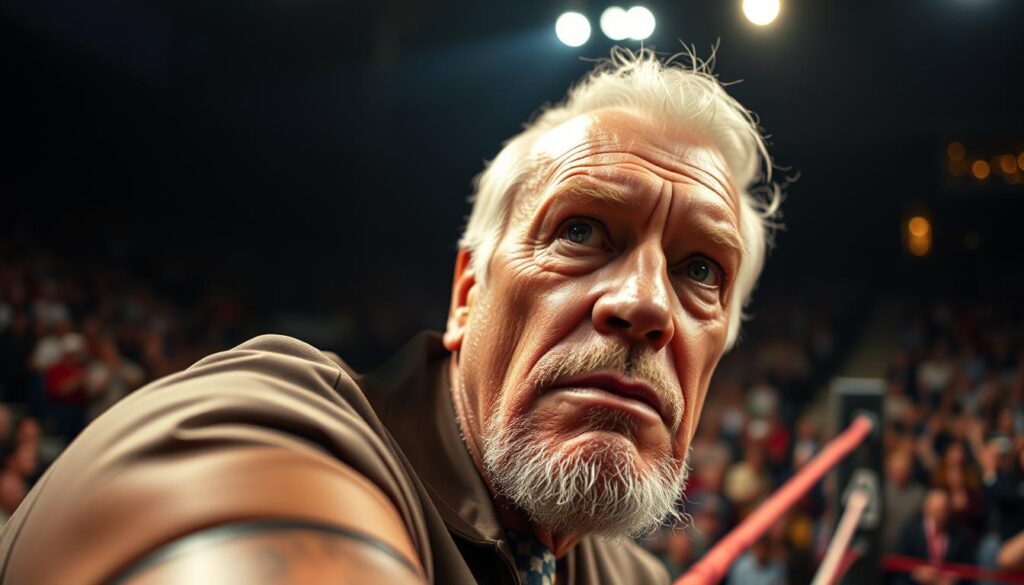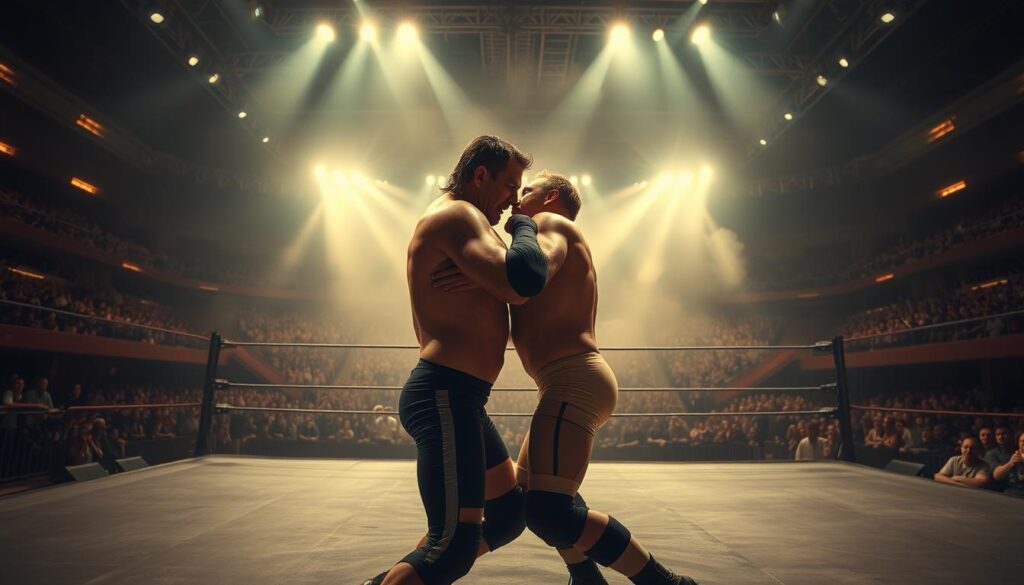What separates a wrestling moment from becoming legend? It’s not just gravity-defying moves or scripted outcomes—it’s the alchemy of crowd electricity, narrative payoff, and that split-second when reality briefly outshines spectacle. Think Darth Vader’s paternity reveal, but with more spandex and body slams.
Take Hulk Hogan hoisting Andre the Giant at WrestleMania III—a feat that rewrote physics and fan expectations simultaneously. The 93,173 fans didn’t just witness a lift; they felt tectonic plates shift beneath pop culture. Decades later, Daniel Bryan’s underdog triumph at WM30 turned a simple “Yes!” chant into a revolution, proving audiences crave catharsis more than pyrotechnics.
These moments work because they’re emotional trigonometry—angles of timing, stakes, and collective investment intersecting perfectly. As WWE’s most visceral chapters show, the magic lies not in choreography alone, but in how performers weaponize vulnerability. A bodyslam becomes Shakespearean. A submission hold feels like therapy.
So next time you see a wrestler leap off a cage, ask: Is this just acrobatics, or the raw calculus of human connection? The answer separates spot monkeys from storytellers.
Emotional Peaks in Wrestling History
How does a staged spectacle make millions feel genuine heartbreak? Pro wrestling’s greatest trick isn’t body slams—it’s manufacturing catharsis through razor-wire storytelling. I’ve watched grown adults sob at Ric Flair’s 2008 retirement, where his whispered “I’m sorry, I love you” became Shakespearean tragedy performed in spandex. The man bled mascara that night, and so did we.
Eddie Guerrero’s 2005 tribute show redefined raw vulnerability. Fans didn’t mourn a character—they grieved a man whose demons played out in prime time. That’s the alchemy: turning predetermined outcomes into cultural touchstones. When ECW’s 2006 revival doubled as a funeral for counterculture wrestling, the tears weren’t just about closure—they mourned lost rebellion.
Even triumph tastes salty here. Kofi Kingston’s 2019 championship win wasn’t just confetti—it was 11 years of systemic doubt vaporized in one leap. These moments work because they borrow reality, stitching our collective hopes and frustrations into the fabric of kayfabe. The ring becomes a therapist’s couch, and we’re all screaming at the same breakthrough.
Wrestling’s magic lies in this paradox: the more scripted it gets, the harder it hits. You don’t cheer the move—you roar for the metaphor. And somewhere between pyro smoke and cheap seats, the work becomes shockingly real.
Ric Flair’s Retirement Emotional Moment
Wrestling’s greatest tragedies aren’t scripted – they’re lived. Ric Flair’s 2008 WrestleMania XXIV retirement match wasn’t just sports entertainment; it was a Greek chorus of jet-fueled excess meeting mortality head-on. The Nature Boy’s career had become indistinguishable from his character – a walking cautionary tale dripping in champagne and crocodile tears. When Shawn Michaels whispered “I’m sorry… I love you” before delivering the final Sweet Chin Music, it wasn’t just a match ending. It was the closing act of wrestling’s most operatic life story.
Flair’s career arc reads like Tennessee Williams rewrote Glengarry Glen Ross with body slams. His “stylin’ and profilin’” persona wasn’t mere gimmick – it was autobiography turned up to 11. The 1992 Royal Rumble victory? Pure Flair theater: 60 minutes of wheeling, dealing, and surviving that made Machiavelli look like a Cub Scout. But by WM24, the limousine-riding had become a hearse ride toward inevitability.
“You don’t retire from wrestling. Wrestling retires you.”
What made this wrestling emotional moment transcendent? Three ingredients even Shakespeare would steal:
| Element | Flair’s Persona | WM24 Execution |
|---|---|---|
| Character Truth | Real-life excess as kayfabe | Flair’s trembling lip during his “career on the line” promo |
| Stakes | Lifetime of near-death experiences | Legit concern he’d die mid-match |
| Catharsis | 60,000 fans chanting “Thank you Flair!” | The curtain call with Four Horsemen |
The magic? WWE didn’t create drama – they bottled Flair’s actual life. His “plane crash survivor turned villain turned tragic hero” narrative needed no script doctors. When he collapsed post-match, tear-streaked mascara mixing with sweat, even cynical marks questioned if this was work or shoot. That’s wrestling emotional moments at their most potent – when reality and spectacle become indistinguishable.
Modern wrestlers study this match like method actors dissect Brando. The trembling hands adjusting imaginary robe tassels. The desperate low blow when facing elimination. Every detail screamed “man clinging to his identity” with Shakespearean desperation. In that Orlando ring, Flair didn’t retire a wrestler – he buried a myth he’d spent 35 years creating.
Eddie Guerrero’s Tribute
Eddie Guerrero’s 2005 tribute episode didn’t just memorialize a wrestler—it redefined how sports entertainment processes grief. WWE transformed raw tragedy into a masterclass in storytelling, blending lucha libre showmanship with Shakespearean pathos. The lowrider entrance that night wasn’t empty pageantry; it was a rolling metaphor for how Latino Heat’s legacy would keep cruising through wrestling history.
Guerrero’s influence physics-defyingly persists. Watch Charlotte Flair’s signature moonsault—the arc mirrors Eddie’s 2004 WrestleMania XX frog splash that left JBL’s ribs permanently dented. As she told ESPN:
“His matches felt like jazz solos—structured chaos that somehow made perfect sense.”
The real magic? How Guerrero’s “Lie, Cheat, Steal” philosophy became wrestling’s unofficial playbook for modern heels. Today’s rule-breakers aren’t just borrowing his tactics—they’re studying his smirk timing and crowd manipulation like method actors:
| Eddie-ism | Modern Adaptation | Cultural Impact |
|---|---|---|
| Chair-assisted victories | Sami Zayn’s “accidental” turnbuckle grabs | Blurs hero/villain lines |
| Fake injury theatrics | Dominik Mysterio’s “innocent” shrugs | Enhances crowd participation |
| Cultural pride entrances | Bad Bunny’s WrestleMania lowrider | Expands Latino fanbase |
What makes Guerrero’s legacy truly untouchable? His ability to make rule-breaking feel like righteous rebellion. Modern crowds don’t boo clever cheats—they demand them. When Rhea Ripley “accidentally” uses the ropes for leverage, that’s not a cheap trick. That’s Eddie’s ghost high-fiving the audience from the rafters.
The 2005 tribute’s genius lay in its refusal to sanitize Eddie’s complexity. WWE let his contradictions breathe—the reformed addict turned locker room leader, the family man who stole showman. In doing so, they created wrestling’s Rosetta Stone for turning personal pain into universal connection. Viva la Legacy, indeed.
Storytelling Techniques to Evoke Emotion Live
What makes 80,000 fans gasp in unison or roar like a jet engine? It’s not luck—it’s calculated emotional architecture. Wrestling’s greatest memorable spots aren’t accidents; they’re narrative grenades with the pins pulled years in advance. Take Savage and Elizabeth’s WrestleMania III reunion: a nine-month slow burn resolved through trembling hands and a single tear, proving melodrama works better when marinated.
The Montreal Screwjob wasn’t just betrayal—it was Shakespeare with suplexes. Bret Hart’s frozen grimace as the bell rang? That’s Macbeth-level tragedy in spandex. Yet even these moments pale next to Bayley and Sasha Banks’ Brooklyn classic, where callbacks piled up like Chekhov’s gun on a wrestling canvas. Every wristlock echoed their developmental past, every near-fall weaponized nostalgia.
Here’s the dirty secret: Your favorite “holy shit” chant likely got rehearsed tighter than Hamilton choreography. The best performers treat arenas like playwrights—act one establishes motives, act two escalates conflict, act three delivers catharsis through memorable spots disguised as chaos. Want proof? Watch Steamboat vs Savage’s WMIII match again. Notice how every arm drag pays off later, like a murder mystery planting clues in round one.
True mastery lies in making scripted violence feel like improv jazz. The crowd’s gasp? That’s not surprise—it’s awe at seeing emotional math solved live.
The Role of Wrestler Performance and Audience Interaction
What makes wrestling drama so addictive? It’s not just spandex-clad theatrics – it’s the electric feedback loop between performers and fans. Think of it as improv theater with body slams, where every gasp, boo, or chant becomes part of the script.
When Dean Ambrose betrayed The Shield in 2014, it wasn’t just a plot twist. It was a cultural detonation – three years of shared history exploding in real time. Fans didn’t just watch the betrayal; they lived it, their collective shock becoming part of wrestling lore.
The 2005 ECW One Night Stand revival took this further. Hardcore fans transformed into co-conspirators, hurling insults and chairs with equal fervor. This wasn’t passive viewership – it was tribal warfare disguised as sports entertainment. As academic analysis of WrestleMania moments shows, these interactions create brief but powerful moments of radical democracy in arenas.
Even John Cena’s career became a live debate stage. “Let’s Go Cena/Cena Sucks” churns split venues like political rallies, proving fans crave participation trophies made of noise. The magic lies in making crowds believe their reactions matter – that through sheer volume, they might rewrite the script.
Authenticity here isn’t about real punches. It’s about crafting stories so compelling that fans forget they’re watching predetermined outcomes. When done right, the line between performer and spectator blurs into something beautifully chaotic – the ultimate payoff in wrestling drama.
Lasting Impact on Wrestling Culture and Fans
What happens when scripted spectacle collides with raw human connection? You get moments that rewrite the rules of an entire industry. Take Mankind’s 1999 title win – a hardcore nobody crashing through the Hell in a Cell ceiling didn’t just shock audiences. It made barbed wire and thumbtacks prime-time television.
The YES Movement wasn’t merely Daniel Bryan’s ticket to WrestleMania. It exposed WWE’s creative bankruptcy like a folding chair to the skull. Fans didn’t just cheer – they hijacked scripts through sheer force of will, proving audiences could out-write the writers.
Ronda Rousey’s WrestleMania 35 main event? That wasn’t progress – it was a cultural earthquake. The same company that once booked bra-and-panties matches suddenly had to pretend they’d supported women’s wrestling all along. Talk about a kayfabe-breaking meta-narrative.
And let’s not mythologize The Undertaker’s Streak as mere statistics. 21-1 is wrestling’s Icarus parable – a 23-year cautionary tale about hubris, delivered through suplexes and tombstone piledrivers. When Brock Lesnar’s fist hit that mat, he didn’t just end a streak. He shattered collective delusions.
These aren’t matches. They’re cultural flashpoints where predetermined outcomes crash into undeniable truths. The ring becomes a mirror – and sometimes, the reflection stares back with Vince McMahon’s horrified face.
The Grammar of Goosebumps: Why Bryan’s WrestleMania Knee Still Resonates
Daniel Bryan’s WrestleMania 30 coronation proves wrestling’s secret sauce: technical precision amplifies emotional voltage. That opening match against Triple H wasn’t just athletic exhibition – it was Shakespearean conflict told through wristlocks and suicide dives. Every European uppercut whispered “underdog,” each YES! chant punctuating the story’s rising action.
Watch Bryan chain-wrestle The Game in real time. His grounded mat work mirrors the narrative – a tactical genius fighting uphill against corporate machinery. When he finally plants Randy Orton and Batista with that running knee, the move transcends physics. It becomes narrative closure, the exclamation mark on a three-year sentence written in sweat and fan revolt.
This alchemy explains why WWE’s most memorable spots outlive their runtime. Bryan’s YES Lock wasn’t just an armbar – it was 70,000 fans screaming in tendon-straining unison. The technical execution (flawless bridging, strategic limb targeting) gave permission to feel. Audiences don’t cheer moves – they applaud meaning.
Want to engineer this magic? Study how Bryan’s technical bout structure (15 minutes of escalating counters) made his triumph inevitable yet shocking. The best wrestling finishers – like Austin’s stunner or Guerrero’s frog splash – work because they’re both biomechanically sound and emotionally loaded. They’re period marks completing sentences we’ve been reading through clenched teeth.
Next time you watch classic matches, reverse-engineer the feels. That electric moment when crowd noise peaks? It’s not random – it’s punctuation. And WrestleMania 30 remains the Oxford comma of sports entertainment: technically optional, emotionally essential.


